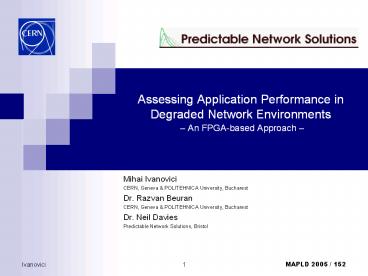MAPLD 2005 / 152 PowerPoint PPT Presentation
1 / 18
Title: MAPLD 2005 / 152
1
Assessing Application Performance in Degraded
Network Environments An FPGA-based Approach
- Mihai Ivanovici
- CERN, Geneva POLITEHNICA University, Bucharest
- Dr. Razvan Beuran
- CERN, Geneva POLITEHNICA University, Bucharest
- Dr. Neil Davies
- Predictable Network Solutions, Bristol
2
Outline
- Motivation
- Application performance assessment methodology
- Network emulator architecture
- Implementation considerations
- The hardware platform
- Experimental results
- Short-lived HTTP transfers over large delay
connections - Conclusions future work
- Acknowledgements
3
Motivation
- Rationale methodology for assessing the effects
of network quality degradation on applications - CERNs interest
- Long-distance networks have high costs ? must
make an optimal use of resources - What affects applications is not so much
quality as the quality degradation (?Q)
experienced - This is something we can reproduce in the
laboratory
4
Influence of quality degradation on application
outcome
- Interaction of Quality Degradation (?Q) and
User-Perceived Quality (UPQ) for VoIP (G.711) - Applications only care about the outcome, not the
mechanisms
5
Networks Degraded Environments
- Assess application performance under varying
network conditions
6
Assessing application performance
- Simultaneously
- Measure the network quality degradation (?Q)
- Assess the UPQ for the application under test
7
Reproducible controllable conditions
- Network emulation
- Hybrid technique that uses real applications
- Wide range of network conditions
8
The architecture
Replaceable modular components
9
Implementation philosophy
- Use of message passing
- Abstraction ? reusability independent module
design - Asynchronous concurrent processes (18)
- Use of Handel-C
- The concept of channels (CSP, Occam)
- Rapid development and translation into hardware
- Easy debugging due to channel-based architecture
- Flexible (custom) design
- Other projects GE tester, sniffers, traffic
emulators
10
The hardware platform
- 1 Altera Stratix FPGA (25 k LEs)
- 2 GE PHYs
- 128 MB SDRAM
- 2 MB SSRAM
- 1 FLASH memory
- 3V3 PCI connector
- IP cores
- MAC IP core
- PCI controller
- SDRAM controller
11
Architectural choice SDRAM access
Direct access / semaphore Client / Server architecture
Inter-domain data transfers using channels are slow (4 cycles per word) Inter-domain data transfers using dual-port on-chip RAM are fast (1 cycle/word)
8-word burst SDRAM operations 8-word burst SDRAM operations
gt600 lines of code 300 lines of code
Achieved rate 400 Mb/s Achieved rate 1 Gb/s
12
The SDRAM Server
Channel selection Read 8-word bursts from
SDRAM 0 1 Confirm operation
completion Write 8-word bursts to SDRAM 0
1 Confirm operation completion
- while( 1 )
- prialt
- case sdram_read_request_channel ? operation
- par
- sdr0_read_burst8(memory_address,
context) - sdr1_read_burst8(memory_address,
context) - sdram_read_response_channel ! (unsigned 1)
1 - break
- case sdram_write_request_channel ? operation
- par
- sdr0_write_burst8(memory_address,
context) - sdr1_write_burst8(memory_address,
context) - sdram_write_response_channel ! (unsigned 1)
1
13
HTTP test results
- Site download duration vs. offered background
traffic load
14
Current emulators
- Do exist
- Mainly software based
- Packet by packet systems
- Independent loss and delay applied to packets ?
unrealistic behaviour - False packet reordering
- Intra-stream contention not modeled
15
Why another emulator?
- More realistic scenarios
- Intra-stream and inter-stream contention
- Correlated loss and delay, natural induced jitter
- Phase / mode changes in network
- Topology or environment changes (e.g. wireless)
- More flexibility and control on the degradation
models
16
Conclusions
- Methodology for assessing application performance
- Network emulator
- Use FPGA ? 1 G/s bidirectional
- High-accuracy operation
- Realistic effects through the use of intra- and
inter-stream contention mechanisms
17
Future work
- Emulate multiple hops
- Implement server with vacations algorithms
- Aggregate models of queues and wires into one
single model - Build a new board
- Bigger and faster FPGA
- External (USB connected)
- Larger SDRAM
18
Acknowledgments
- Brian Martin and Jaroslav Pech for designing the
board - Matei Ciobotaru for implementing the low-level
libraries for access to board components

